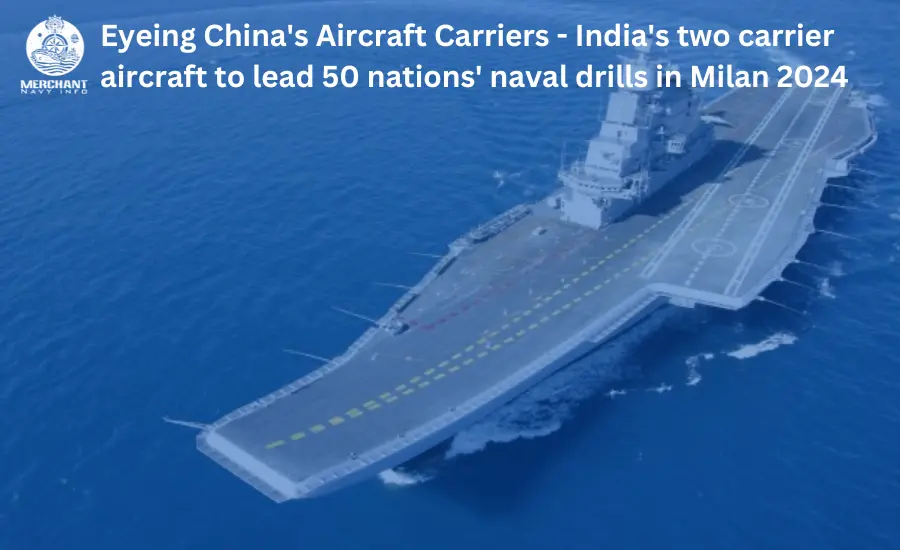
At the end of February 2024, India will flex its Naval muscle in Milan drills. With an eye on China, an armada of 50 navies will assemble in the strategically vital Bay of Bengal. Thus giving an unmistakable message of ensuring a secure and stable Indo-Pacific in the face of China’s aggressiveness in the region.
Indian Navy’s twin aircraft carriers (INS Vikramaditya and the INS Vikrant. Also, foreign submarines will be the stars of the exercise.
Apart from the Quad countries – the US, Japan, and Australia, navies of south-eastern countries will participate in the Milan maritime exercise. India will be deploying its twin aircraft carriers. They are the INS Vikramaditya and INS Vikrant, for the exercise. This will take place from February 19 to 27. Besides these, 20 naval warships, maritime patrol aircraft like P-8I, and submarines will be participating in the exercise.
“The sea phase of the naval exercise will involve large-force maneuvers. Also, advanced air defence operations, anti-submarine warfare, and anti-surface operations,” a naval official told Merchant Navy News. This will be the 12th edition of the Milan exercise, and it will be the largest.
The ‘Harbour phase’ of the exercise would comprise an International Maritime Seminar, International City Parade. Also, Maritime Tech Exhibition, Subject Matter Expert Exchange, Milan of Young Officers. Lastly, various sporting events.
Navies from many countries took part. The US, Japan, Australia, France, Bangladesh, South Korea, Vietnam, Indonesia, and Malaysia are some of the countries expected to participate in the exercise. The exercise aims to help friendly navies in the region achieve synergy. Also, reiterate commitment to open, inclusive, and rules-based global order in the Indo-Pacific. Which is being threatened by China’s increasing aggression.
China has been muscle-flexing in the Indo-Pacific region coming in direct conflict with Japan and the US, primarily in the East and South China Seas. The situation with the Philippines and Taiwan has also been fluid for several years.
India, on its part, has been actively engaging with the Southeast Asian countries, and its engagement with the Quad countries has also increased considerably.
But the exercise is not only meant as a show of force. It is also for diplomatic outreach among many key players. Including the United Kingdom, Israel, Saudi Arabia, Iraq, Iran, Oman, Qatar, Kuwait and UAE, Brunei, the Philippines, Maldives, Kenya, Indonesia and Mauritius.
The exercise comes at a time when the freedom of navigation in the Red Sea is threatened by Houthi militia and Somali pirates.
The Iranian-backed Houthis rebels are targeting commercial ships, making the trade expensive. The Indian Navy has been the primary responder against the piracy bids in the Arabian Sea. Mainly around the Gulf of Aden and Horn of Africa, where Somalian pirates have created a maritime menace.
According to an official statement, “for restoring maritime security in the region. In addition, enhanced presence of ships, aerial surveillance by maritime patrol aircraft. Also, RPA (Remotely-Piloted Aircraft) in the Central Arabian Sea and Off East of Coast of Somalia is being undertaken by Indian Navy.’’
The Indian Navy’s area of influence extends from the Gulf of Aden in the West. All the way to the Malacca Strait in the East. For this, it has deployed 50 warships to escort merchant vessels through the 490 nautical mile-long Internationally Recommended Transit Corridor (IRTC).
Minister of State for Defense Ajay Bhatt told the Parliament that “since 2008, Indian Navy has deployed units in Gulf of Aden. Also, East Coast of Africa towards anti-piracy patrols.
While the Indian Navy is playing a yeoman role in defending commercial shipping from pirates and missile attacks in the Arabian Sea. Maritime security in the Indo-Pacific is currently under threat. China and the rapidly expanding PLA Navy playing the hegemon in the South China Sea.
Previous Editions Of Milan
The 11th edition of Milan took place in 2022 amid tensions between the West and Russia. The warships from Quad countries participated in the exercise along with France, Myanmar, South Korea, and Vietnam.
Russia, Israel, Iran and Saudi Arabia, among others, participated in the exercise without ships. A total of 39 countries participated in the exercise.
The first two days of exercises on the ocean included complex anti-air warfare drills with US P8A aircraft. In this leading a strike of Indian fighter aircraft on a formation of battle ships of the participating navies.
Helicopters conducted cross deck operations. Also, ships from the participating countries took turns to replenish at sea with the Indian Navy’s tanker. The sea phase saw the practice of anti-submarine exercises.
The sea phase witnessed the participation of 26 ships, one submarine, and 21 aircraft.
Starting with the participation of several countries – Indonesia, Singapore, Sri Lanka, and Thailand – in 1995. Since then the exercise has since transitioned in terms of the number of participants and complexity of exercises.









